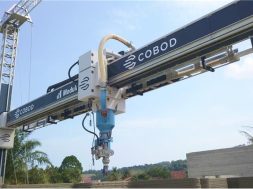CONSTRUCTECHNOVATION

6 breakthrough innovations that will change the future of construction industry
Technology is transforming the construction industry like never before. With the aim of addressing major problems and opening up new opportunities, technologies are being developed at a rapid pace. Here are our picks. The stated technologies have huge potential to transform the construction industry space completely.
Scaffold that reduces air pollution by 20%
Arup, together with Grosvenor have unveiled an innovative new ‘living wall’ in Mayfair that can reduce air pollution by up to 20 per cent.
The structure, which is being trialled in the UK for the first time, has been installed on scaffolding at the St Mark’s building, a Grade I listed property. Grosvenor is transforming the property to create new retail and community space, which is due to complete in 2017.

The wall, named ‘Living Wall Lite’, spans 80 sq.m. and comprises a mixture of grasses, flowers and strawberries, reducing the visual impact of scaffolding on local residents. Apart from improving air quality, studies have also found that the wall can reduce noise pollution by up to 10 decibels.
Living Wall Lite has been designed by Arup and manufactured by Swedish living wall specialist Green Fortune, and will be fitted with sensors to monitor its impact on noise, temperature and air pollution.

Smart sensing and analysis
Drones, also known as UAVs (unmanned aerial vehicles), are changing the way construction activities are performed at the jobsite. As the technology is gaining acceptance by the global construction industry at large, advanced sensing technology to enable better surveying and mapping is being incorporated at a giant stride.
Accelerating its efforts in developing aerial technology for the construction industry, information technology giant Intel is setting a new standard for commercial-grade drones, incorporating full electronic system redundancy and automated aerial-sensing solutions with best-in-class onboard sensors. The company has introduced Falcon 8+ system which provides detailed images down to millimeter accuracy and gives valuable structural analysis that helps users detect and prevent further damage to infrastructure. Operators will have tremendous opportunities to generate valuable aerial precision data, the company claims.

The United States based Sentera recently announced new aerial data-capture capabilities as part of its Omni Quad-Rotor UAV that enables precision inspection, survey and mapping. The UAV empowers users to collect precise data from obscure angles, an Omni+ Double 4K Sensor package simultaneously captures macro and micro data and provides the user with true distortion-free imagery.
Buildings may “sense” internal damage
When a truck rumbles by a building, vibrations can travel up to the structure’s roof and down again, generating transient tremors through the intervening floors and beams.
MIT researchers have developed a computational model that analyses such ambient vibrations, picking out key features in the noise that give indications of a building’s stability. The model may be used to monitor a building over time for signs of damage or mechanical stress.

The model is tested on MIT’s Green Building — a 21-storey research building made completely from reinforced concrete. The building was designed in the 1960s by architect and MIT alum I.M. Pei ’40, and stands as the tallest structure in Cambridge, Massachusetts.
“I would envision that, in the future, such a monitoring system will be instrumented on all our buildings, city-wide,” says lead author Hao Sun. “Outfitted with sensors and central processing algorithms, those buildings will become intelligent, and will feel their own health in real time and possibly be resilient to extreme events.”
Technology to improve efficiency at construction sites
A Purdue University graduate’s ideas to utilise sensors and a software platform could lead to greater efficiency at future construction sites.
Joseph Louis, who recently earned a doctorate in civil engineering from Purdue’s Lyles School of Civil Engineering, used technology he was working on while he was pursuing the degree to co-found SAMCRO Technologies LLC along with his adviser Phillip Dunston, a professor in the Lyles School of Civil Engineering. SAMCRO stands for Simulation Analysis Monitoring and ContRol of Operations.
The technology combines pre-existing sensors on equipment at a construction site with an operational model of the site. Together the components provide a real-time overview of the site via a software platform, which could help control time and cost overruns.
Louis compares the system to making use of the onboard diagnostics in current passenger vehicles.
“For example, sensors on a truck can tell you it’s speed, how much payload it’s carrying, whether the bed is up or down,” he said. “The idea is to determine what the truck is doing – its state – at any given moment and feeding it into an operational model. Once the current task is complete, the operational model is updated in real-time to reflect the latest status of the operation.”
The technology puts the sensor data into the context of the operations, which allows the manager to monitor progress; make real-time, data-driven tactical decisions; and automate the worksite at an operational level.
Technology that removes £1 mn of non-productive time
International construction services company ISG has announced findings of the ground-breaking technology being tested on Europe’s largest office fit-out, 5 Broadgate in London. “The Construct app, trialled on the 700,000 sq ft project, produced a daily administration saving of one and a half hours per employee on average, equating to £1 million of non-productive time,” ISG claims.
Construct is a fully customisable information and process management system for on-site construction work. It makes sites completely paperless, massively reducing costs and inefficiencies. By tailoring itself to the way teams already work, it reduces the need to learn new processes and systems.
According to ISG, “With Construct, managers have all the information they need to hand and therefore save time on trips to the office. It saves at least 1.5 hours per employee per day or around 25 per cent of their time.”
Autonomous construction
Construction industry is becoming highly mechanised. Thus there is the need for safer jobsites with the work being done more efficiently and accurately. Construction equipment manufacturing giants are developing ‘driverless’ machines with no manual controls to address these issues. In September last year, Volvo Construction Equipment demonstrated its prototype autonomous wheel loader and articulated hauler working together.

The company presented an exclusive demo of its prototype autonomous wheel loader and articulated hauler working together at the company’s Xploration Forum, Sweden.
The prototype wheel loader filled the prototype articulated hauler – before dumping its load and repeating the cycle. According to Volvo CE, “In a one-hour comparison it was found that the autonomous wheel loader could reach the equivalent of 70 per cent of that of a skilled operator’s productivity levels when loading and unloading.”
Foreword
This time, we made an attempt to discover how technology is rebuilding the construction industry. In subsequent articles, major players from construction equipment, building materials and architectural solutions industries have explained the advancements in their respective fields whereas leading architects, city planners and project developers have discussed on why Indian construction industry should embrace such advanced technologies.
24
Cookie Consent
We use cookies to personalize your experience. By continuing to visit this website you agree to our Terms & Conditions, Privacy Policy and Cookie Policy.









